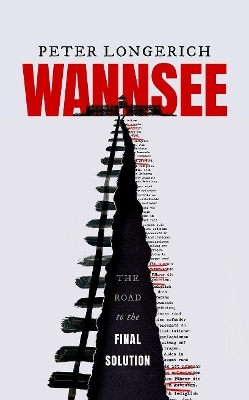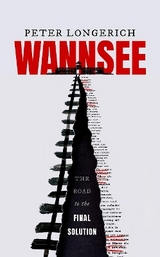Wannsee
The Road to the Final Solution
Seiten
2021
Oxford University Press (Verlag)
978-0-19-883404-5 (ISBN)
Oxford University Press (Verlag)
978-0-19-883404-5 (ISBN)
The complete story of the Wannsee Conference, the meeting that paved the way for the Holocaust.
On 20 January 1942, fifteen men arrived for a meeting in a luxurious villa on the shores of the Wannsee in the far-western outskirts of Berlin. They came at the invitation of Reinhard Heydrich and were almost all high-ranking Nazi Party, government, and SS officials. The exquisite position by the lake, the imposing driveway up to the villa, culminating in a generously sized roundabout in front of the house, the expansive, carefully landscaped park, the generous suite of rooms that opened on to the park and the lake, the three-level terrace that stretched the entire garden side of the house, and the winter garden with its marble fountain, all give today's visitor to the villa a good idea of its owner's aspiration to build a sophisticated, almost palatial structure as a testament to his cultivation and worldly success.
But the beauty of the situation stood in stark contrast to the purpose of the meeting to which the fifteen had come in January 1942: the 'Final Solution of the Jewish Question'. According to the surviving records of the meeting, items on the agenda included the precise definition of exactly which group of people was to be affected, followed by a discussion of how upwards of eleven million people were to be deported and subjected to the toughest form of forced labour, and following on from this a discussion of how the survivors of this forced labour as well as those not capable of it were ultimately to be killed. The next item on the agenda was breakfast.
On 20 January 1942, fifteen men arrived for a meeting in a luxurious villa on the shores of the Wannsee in the far-western outskirts of Berlin. They came at the invitation of Reinhard Heydrich and were almost all high-ranking Nazi Party, government, and SS officials. The exquisite position by the lake, the imposing driveway up to the villa, culminating in a generously sized roundabout in front of the house, the expansive, carefully landscaped park, the generous suite of rooms that opened on to the park and the lake, the three-level terrace that stretched the entire garden side of the house, and the winter garden with its marble fountain, all give today's visitor to the villa a good idea of its owner's aspiration to build a sophisticated, almost palatial structure as a testament to his cultivation and worldly success.
But the beauty of the situation stood in stark contrast to the purpose of the meeting to which the fifteen had come in January 1942: the 'Final Solution of the Jewish Question'. According to the surviving records of the meeting, items on the agenda included the precise definition of exactly which group of people was to be affected, followed by a discussion of how upwards of eleven million people were to be deported and subjected to the toughest form of forced labour, and following on from this a discussion of how the survivors of this forced labour as well as those not capable of it were ultimately to be killed. The next item on the agenda was breakfast.
Peter Longerich was until 2015 Professor of Modern German History at Royal Holloway University of London, and was a founder of the College's Holocaust Research Centre. An internationally renowned authority on the Nazis, his previous publications include Holocaust: The Nazi Murder and Persecution of the Jews (OUP 2010), Himmler (OUP 2012), and Hitler: A Life (OUP 2019).
Prologue
1: The Background to the conference: the 'Removal of the Jews', 1933-1941
2: The Wannsee Conference
3: The 'final solution' becomes a reality
4: Conclusion: The Wannsee Conference in historical context
Appendix
Abbreviations
Notes
Bibliography
Index
| Erscheinungsdatum | 16.09.2021 |
|---|---|
| Übersetzer | Lesley Sharpe, Jeremy Noakes |
| Verlagsort | Oxford |
| Sprache | englisch |
| Maße | 141 x 223 mm |
| Gewicht | 324 g |
| Themenwelt | Geschichte ► Allgemeine Geschichte ► 1918 bis 1945 |
| Geschichte ► Teilgebiete der Geschichte ► Militärgeschichte | |
| Sozialwissenschaften ► Politik / Verwaltung ► Politische Systeme | |
| Sozialwissenschaften ► Politik / Verwaltung ► Politische Theorie | |
| ISBN-10 | 0-19-883404-7 / 0198834047 |
| ISBN-13 | 978-0-19-883404-5 / 9780198834045 |
| Zustand | Neuware |
| Informationen gemäß Produktsicherheitsverordnung (GPSR) | |
| Haben Sie eine Frage zum Produkt? |
Mehr entdecken
aus dem Bereich
aus dem Bereich
ein Psychologe erlebt das Konzentrationslager
Buch | Hardcover (2024)
Kösel (Verlag)
22,00 €
Mythos „Stauffenberg-Attentat“ – wie der 20. Juli 1944 verklärt und …
Buch | Hardcover (2024)
Goldmann (Verlag)
24,00 €




